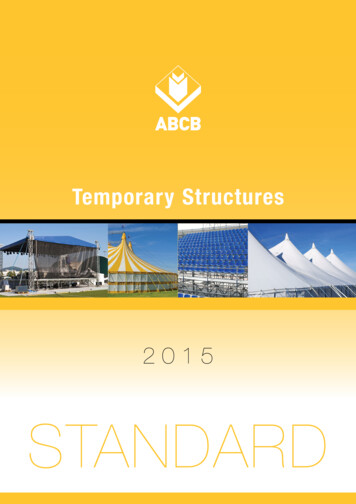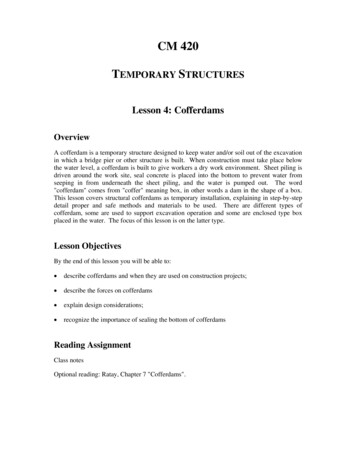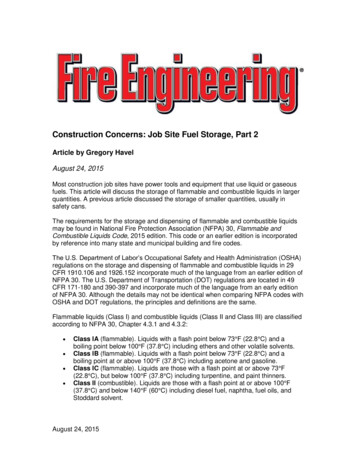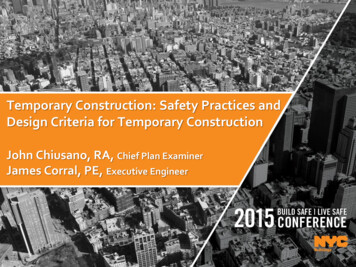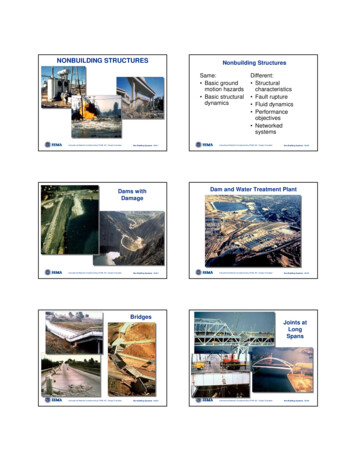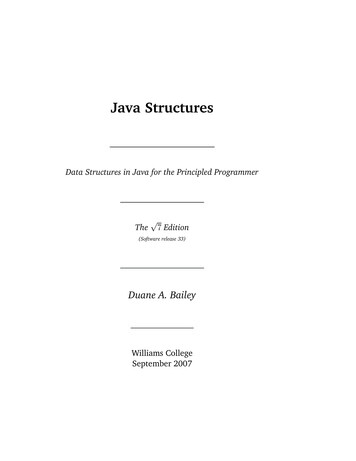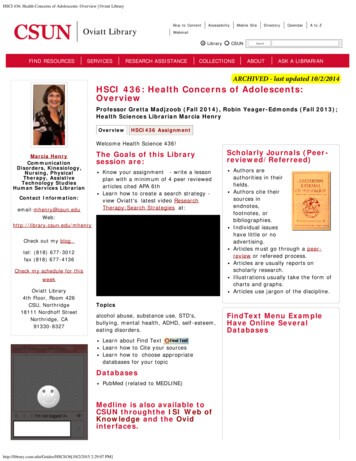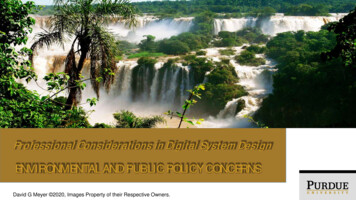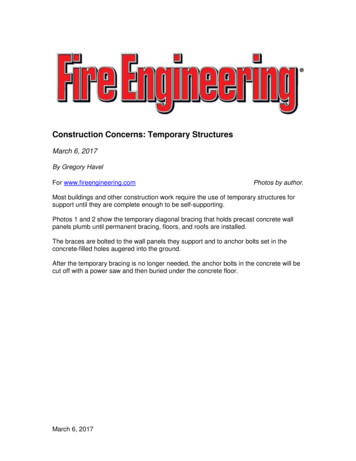
Transcription
Construction Concerns: Temporary StructuresMarch 6, 2017By Gregory HavelFor www.fireengineering.comPhotos by author.Most buildings and other construction work require the use of temporary structures forsupport until they are complete enough to be self-supporting.Photos 1 and 2 show the temporary diagonal bracing that holds precast concrete wallpanels plumb until permanent bracing, floors, and roofs are installed.The braces are bolted to the wall panels they support and to anchor bolts set in theconcrete-filled holes augered into the ground.After the temporary bracing is no longer needed, the anchor bolts in the concrete will becut off with a power saw and then buried under the concrete floor.March 6, 2017
(1)(2)March 6, 2017
In photo 2, some of the braces are bolted to the foundation walls rather than to anchorbolts set in holes filled with concrete. Photo 2 also shows additional bracing between thewall panels and the midpoints of the wall braces because of the height of the wall panelsto prevent the wall braces from buckling under wind load.Photo 3 shows the temporary structure (falsework) that supports a plywood form for asteel-reinforced structural concrete floor.(3)From the top, this system includes the following: The plywood form for the bottom of the structural concrete floor.The aluminum alloy joists that support the plywood.The wood beams that support the aluminum joists.The “shoring scaffold” that supports the wood beams.The screw jacks at the bottom of the shoring scaffold that allow preciseadjustment of the level of the plywood form.Wood mudsills resting on compacted soil.Photo 4 shows the temporary structure that supports the plywood form for a sloped,steel-reinforced structural concrete floor in an auditorium.March 6, 2017
(4)From the top, this system includes the following: The plywood form for the bottom of the structural concrete floor.The wood joists that support the plywood.The wood beams that support the wood joists.The telescoping steel columns with screw jacks in the middle that allow preciseadjustment of the level of the plywood form.Wood mudsills resting on a concrete slab supported by compacted soil.Photo 5 shows the temporary structure that supports the plywood form for a posttensioned concrete floor in a hotel.March 6, 2017
(5)From the top, this system includes the following: The plywood form for the bottom of the post-tensioned concrete floor.The aluminum alloy joists that support the plywood.The beams that support the joists.The telescoping columns with screw jacks in the middle that allow preciseadjustment of the level of the plywood form. These columns have wood “X”bracing to stiffen the columns because of their height.Wood sills resting on the finished post-tensioned concrete floor, runningperpendicular to the length of the tendons in the concrete.Photo 6 shows a trench for installation of a sanitary sewer main in the early 1970sbefore the days of the U.S. Department of Labor’s Occupational Safety and HealthAdministration (OSHA).March 6, 2017
(6)OSHA’s regulations are intended to preserve the lives and health of construction andindustry workers. Although this trench [about seven feet (2.133 meters) deep] has noobstructions to the laying of the pipe; there is a high risk of the collapse or cave-in of thevertical walls of the trench, which can bury workers and cause serious injury or death.Photo 7 shows a modern method of horizontal trench shoring that complies with OSHA’sregulations for excavation and trenching. This device is called a “trench shield” or “trenchbox,” and is made of two vertical steel panels that protect the workers in the trench froma cave-in. The two steel panels are separated by square tubular struts whose length canbe adjusted to the width of the trench. Although the trench is somewhat obstructed whenthe pipe is laid, this is a reasonable trade-off for the safety of the workers on this project.Since this method of shoring has a limited safe work area at the bottom of the trench, theinspectors must be on site at all times while trenching and pipelaying are under way. Asthe pipe is laid, the trench box is pulled forward by the excavating machine, and thetrench with the completed pipe is backfilled behind it.March 6, 2017
(7)Emergency response to construction job sites can be challenging because of therestricted access, the obstacles provided by the vertical or horizontal shoring, and theinfrequent need for these responses. Vertical and horizontal shoring members usuallycannot be removed for rescue access unless the load they carry can be transferred toother shoring members already in place, or newly constructed. If the shoring is involvedin a fire, the shoring system is already weakened, liable to collapse, and may requireinstallation of additional shoring after the fire is out (and before emergency servicesworkers enter the area).Emergency responders need standard operating procedures or guidelines for the workthey may be require to do on construction job sites. These should cover both trench andhigh-angle rescue as well as work in areas with diagonal bracing and vertical shoring likethose shown in photos 1-5.On projects of long-duration such as like the 30-story hotel shown in photo 5, emergencyresponders should work with the management of the job site to prepare medicalassistance, rescue, and firefighting plans. A key to these plans is basic fire preventionMarch 6, 2017
and protection, including the prohibition of storage (especially of combustibles) in anarea obstructed by vertical shoring. Other keys are onsite water supply from hydrants onthe job site; construction roads capable of supporting aerial fire apparatus; and workingstandpipes with fire pumps, terminating no more than two floors below the presenthighest work level.Most building owners and construction managers are very conscious of their publicimage, and they have people who promote this image in a positive way. They will usuallybe happy to provide assistance in preincident planning and nonemergency tours of thejob site by responders, realizing that the cost of this cooperation is small when comparedto the negative publicity of an emergency response and the follow-up visits by regulatoryauthorities.Gregory Havel is a member of the Town of Burlington (WI) FireDepartment; retired deputy chief and training officer; and a 30-yearveteran of the fire service. He is a Wisconsin-certified fire instructorII, fire officer II, and fire inspector; an adjunct instructor in fireservice programs at Gateway Technical College; and safety directorfor Scherrer Construction Co., Inc. Havel has a bachelor's degreefrom St. Norbert College; has more than 30 years of experience infacilities management and building construction; and has presentedclasses at FDIC.CLICK HERE for more 'Construction Concerns' articles!MORE CONSTRUCTION CONCERNS Temporary Heat—Air QualityPreincident PlansRecycled Building MaterialsCombustible LiquidsPenetrations of Rated Wall and Floor AssembliesFire Containment, Part 2Fire Containment, Part 1Construction Site ResponseBridge Cranes9/11 RevisitedConcrete—Modern and AncientConcrete-Reinforcing SteelProscenium Fire CurtainsMarch 6, 2017
Construction Concerns: Temporary Structures March 6, 2017 By Gregory Havel For www.fireengineering.com Photos by author. Most buildings and other construction work require the use of temporary structures for support until they are complete enough to be self-supporting. Photos 1 and 2 show the temporary diagonal bracing that holds precast concrete wall panels plumb until permanent

